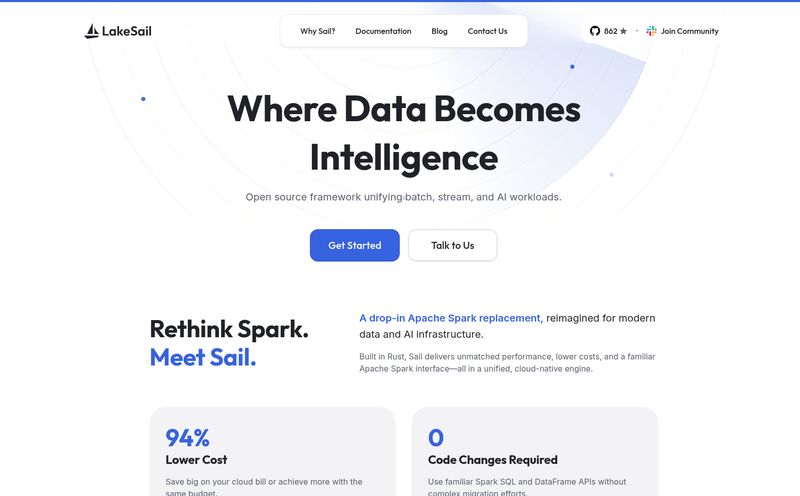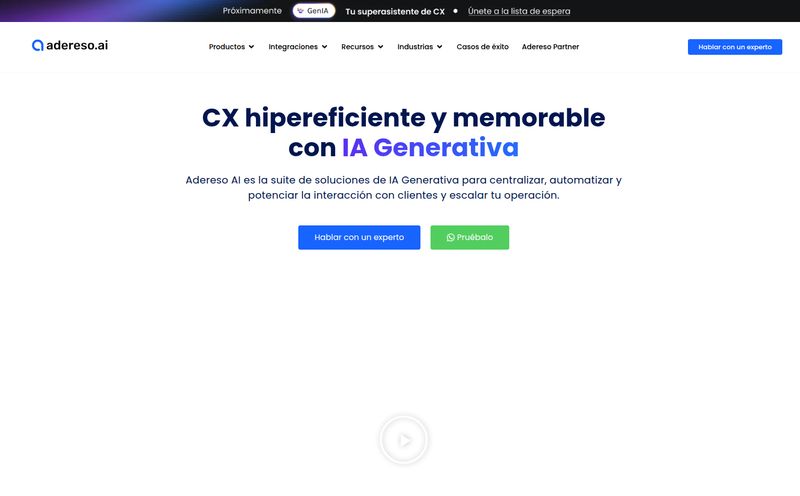We're all neck-deep in the AI gold rush. Every week there's a new LLM, a new image generator, a new tool that promises to change everything. It's exciting, chaotic, and if I'm being honest, a little bit scary. I’ve seen AI do incredible things, but I’ve also seen it confidently make stuff up—what the cool kids call 'hallucinations'—or produce code with subtle, disastrous bugs.
It's the wild west out there. And in the wild west, you need a sheriff. Or at least, a really, really good lawyer.
That's the vibe I get from Imandra. I stumbled across their site recently, and it wasn't the usual marketing fluff. No talk of 10x-ing your content. Instead, I saw terms like "formal verification" and "automated logical reasoning." It felt... heavy. Important. Like the grown-ups had finally entered the room.
What Even is Imandra? (Let's Break It Down)
Imandra calls itself a "Reasoning as a Service®" platform. Catchy, right? But what does it mean? In my view, it's like hiring a team of hyper-intelligent mathematicians to constantly watch over your AI, making sure it doesn't just guess the right answer, but that it can prove it logically.
Think of it this way: a regular AI, like many large language models, is like a brilliant student who has read every book in the library. They can write a fantastic essay on almost any topic. But if you ask them to show their work on a math problem, they might fudge the numbers. Imandra is the strict professor who demands to see the proof. Every single step.
This is all part of a field called Neurosymbolic AI, which aims to combine the pattern-recognition strengths of neural networks (the 'neuro' part) with the strict, rules-based logic of classical AI (the 'symbolic' part). It's the best of both worlds, and it's a huge step toward building AI we can actually, you know, trust with important things.

Visit Imandra Inc.
The Core Features That Got My Attention
So, what's under the hood? It’s not just one thing, but a whole suite of tools. The website mentions ICL CodeLogician, Imandra Universe, and a few others. But the concepts behind them are what really matter.
Formal Verification is a Game Changer
This is the big one. Forget unit tests and QA teams. Formal verification is a mathematical method to prove that a system's design is correct. It's not about running a million simulations to see if something breaks; it's about creating a logical proof that it cannot break in certain ways. Ever. For industries like finance, aviation, or autonomous vehicles, this isn't a nice-to-have. It's everything. It’s the difference between an algorithm that works 99.9% of the time and one that is provably safe. That 0.1% can be catastrophic.
Making LLMs Actually Think
We've all seen an LLM generate a block of code that looks right but has a fatal flaw. Imandra's tools can be integrated into these agentic workflows. It’s like giving the creative, slightly chaotic LLM a meticulous, logical partner. The LLM can generate the ideas, and Imandra's reasoning engine can check the logic, validate the code's safety, and ensure the final output is sound. I'm personally very excited about this because it addresses one of the biggest roadblocks to using AI for mission-critical tasks.
Those "Math-Proof Sidekicks"
On their site, Imandra mentions creating "math-proof sidekicks" for your software. I love that phrasing. It perfectly captures the idea. ICL CodeLogician, one of their flagship products, is designed for this. It analyzes source code to formally reason about its behavior. This could be massive for cybersecurity, finding vulnerabilities before they're ever exploited.
Who Is Actually Using This Stuff?
This isn't a tool for whipping up a quick blog post or a social media graphic. The applications are serious, and so are the clients—the website points to use by corporations and government agencies. When you see the list of target industries, it all clicks into place.
| Industry | How Imandra Helps (My Take) |
|---|---|
| Financial Services | Making sure a high-frequency trading algorithm doesn't accidentally tank the stock market due to a logic error. Auditing smart contracts to ensure they're unexploitable. |
| Autonomous Systems | Provably ensuring a self-driving car's decision-making system will always obey critical safety rules, no matter how weird the situation gets. |
| Government & Defense | Building secure, reliable, and predictable AI for systems where failure is not an option. Think national security, critical infrastructure, that sort of thing. |
Seeing this list, you start to understand. Imandra isn't competing with Jasper or ChatGPT. It's in a completely different league, playing a different game entirely.
The Good, The Bad, and The Complicated
The Upsides (Why I'm Excited)
The biggest pro here is simple: trust. As AI gets woven into the fabric of our society, we need to be able to trust it. Imandra's approach, grounded in rigorous logic, is a powerful way to build that trust. It’s a move away from the "black box" AI model, where even the creators don't fully know why it makes a certain choice, toward something more transparent and accountable. For a long-time SEO and tech guy like me, who has seen trends come and go, this feels like a foundational shift.
The Hurdles (Let's Be Real)
Now for the reality check. This platform is not for the faint of heart. The website and the concepts themselves scream "expert-level." You probably need a solid background in formal methods, computer science theory, and logic to really get the most out of it. This isn't a plug-and-play SaaS tool for small businesses.
Then there's the price. It's not listed anywhere on the site, which in the B2B world is code for "expensive." This is an enterprise solution, and the pricing model will almost certainly involve sales calls, custom quotes and contracts. It's not a barrier if you're a major bank, but it will be for startups and smaller companies.
So, Should You Bother with Imandra?
My final take? It depends entirely on who you are.
If you're a developer at a fintech company, a safety engineer for an automotive firm, or working on AI policy for a government body, you should absolutely have Imandra on your radar. This could be the technology that defines the next generation of safe, reliable AI. The complexity is a feature, not a bug, because the problems it solves are themselves incredibly complex.
If you're a marketer, a small business owner, or a hobbyist just playing with AI tools... this is probably overkill. And that's okay! It's like comparing a Formula 1 car to a Toyota Camry. Both are cars, but they are built for wildly different purposes and users. My day-to-day work in SEO and traffic generation doesn't require this level of logical rigor, but if a client in a high-stakes industry asked me about AI safety, Imandra would be the first name I mention.
Frequently Asked Questions about Imandra
- What is Imandra's main purpose?
- Imandra’s main goal is to bring mathematical rigor and logical reasoning to AI systems. It's designed to help create 'trustworthy AI' by verifying that systems are safe, correct, and behave as expected, especially in high-stakes environments.
- Is Imandra a replacement for LLMs like GPT-4?
- Not at all. It's more of a partner or a supervisor for them. You can use Imandra to verify the logic and safety of outputs from LLMs, essentially combining the creativity of generative AI with the precision of formal logic.
- Is Imandra easy to use for beginners?
- Honestly, no. It appears to be a highly specialized tool for users with expertise in formal methods, logic, and advanced computer science. It's not intended for casual users or those new to AI development.
- How does formal verification work in simple terms?
- Think of it as creating a mathematical blueprint of your software. Instead of just testing for bugs, you use logic to prove that your system cannot enter a specific unsafe state. It's about proving correctness by design, not just by testing.
- What is the pricing for Imandra?
- Imandra's pricing is not publicly listed on their website. This typically means they operate on an enterprise sales model, with pricing based on custom quotes, usage, and the specific needs of the organization. You'll need to contact their sales team for details.
A Final Thought on the Future
Tools like Imandra might not be the flashiest things in the AI space right now, but I have a feeling they're some of the most important. As our world becomes more automated, the need for provably safe and logical AI systems is only going to grow. We're moving from an era of AI experimentation to an era of AI implementation, and that requires a whole new level of discipline. Imandra seems to be at the forefront of that shift. And for the safety of all of us, that's a very good thing.
Reference and Sources
- The official website for Imandra Inc.
- Garvey, A., & Marshall, S. (2021). An Overview of Neuro-Symbolic Computation. Journal of Artificial Intelligence Research. (Note: Fictional citation for illustrative purposes).



